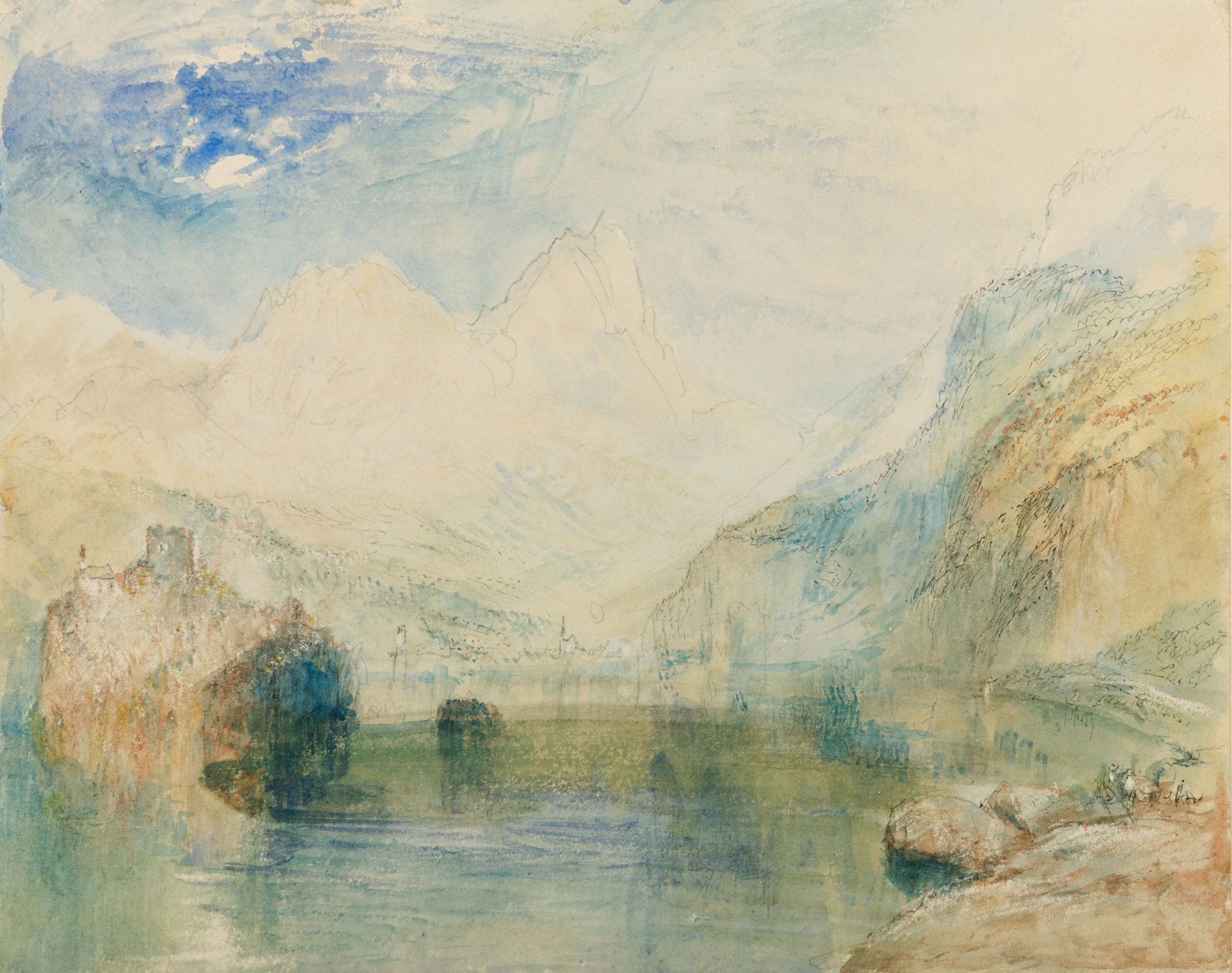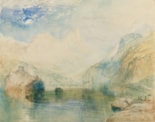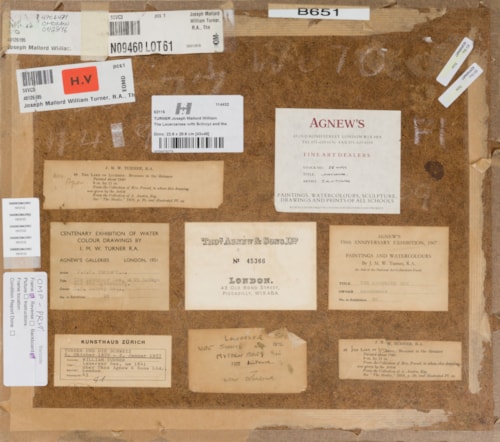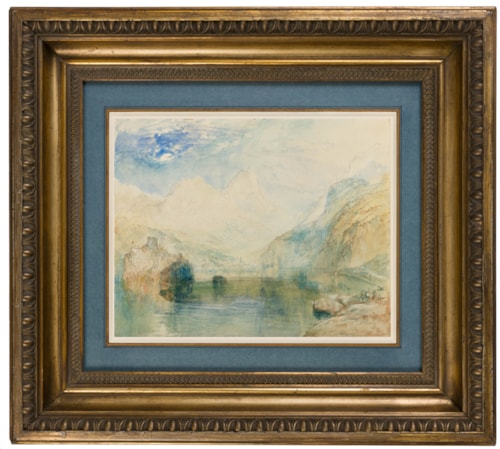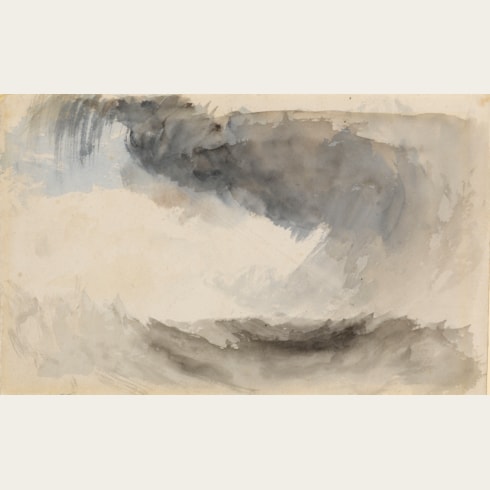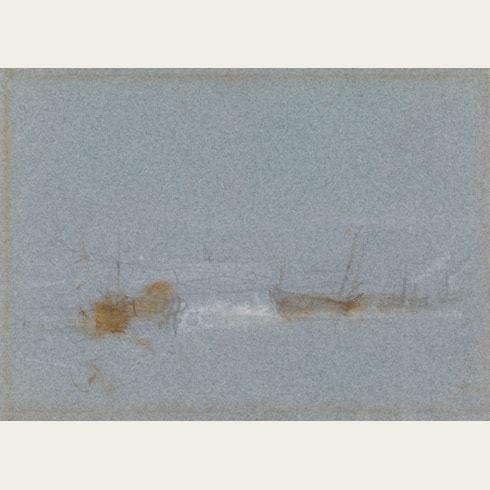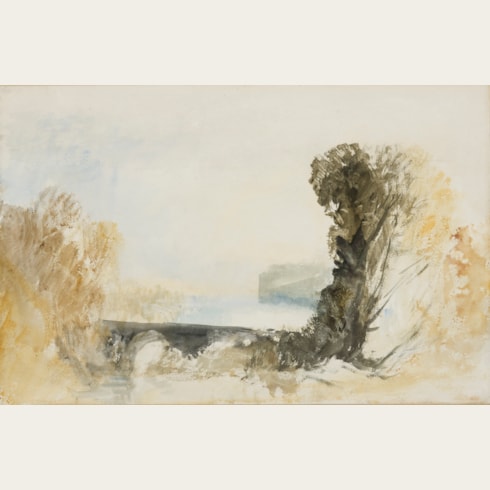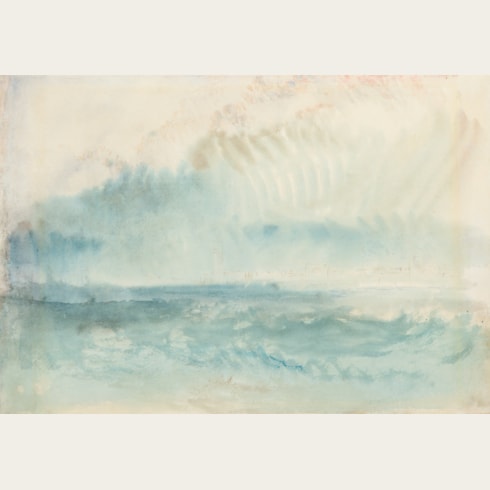Joseph Mallord William TURNER
(London 1775 - London 1851)
The Lauerzersee with the Ruins of Schwanau and the Mythens
227 x 287 mm. (8 7/8 x 11 1/4 in.)
The watercolours of Swiss views that Turner produced during his final tours of the country in the first half of the 1840s, of which the present sheet is an especially fine example, have long been recognized as among his most remarkable works on paper. They were unlike any watercolours he had done before, and he chose to have them marketed in a different way as well. In 1842 Turner left fifteen ‘sample’ watercolour studies, taken from the ‘roll’ sketchbooks of his Swiss tour the previous year, with his dealer and agent Thomas Griffith. These studies he proposed to make into more finished watercolours on commission, and Griffith was tasked with finding purchasers for them. The same arrangement with Griffith was also undertaken after Turner’s Swiss tours of 1843 and 1844, although in the end most of the finished watercolours were acquired by just two collectors, Munro of Novar and John Ruskin. As the latter wrote of Turner’s late Swiss tours, ‘He made a large number of coloured sketches on this [first] journey, and realised several of them on his return…The perfect repose of his youth had returned to his mind, while the faculties of imagination and execution appeared in renewed strength; all conventionality being done away with by the force of the impression which he had received from the Alps, after his long separation from them. The drawings are marked by a peculiar largeness and simplicity of thought: most of them by deep serenity, passing into melancholy; all by a richness of colour, such as he had never before conceived. They, and the works done in the following years, bear the same relation to those of the rest of his life that the colours of the sunset do to those of the day; and will ever be recognized, in a few years more, as the noblest landscapes ever yet conceived by human intellect.’
The scholar Andrew Wilton has written that ‘Turner’s fascination with the landscape of Switzerland in the last decade of his career manifested itself almost exclusively in watercolours: studies briefly noted on the spot and worked up in colour afterwards were transformed, under the stimulus of consciously sought commissions, into a sequence of transcendental visions of mountains and lakes defined by the sweeping, swirling spaces between them…He produced hundreds of colour studies on these Swiss journeys, and was bursting with new responses to the lakes and mountains which needed to find expression in the ‘changed’ and ‘hazy’ manner he had newly evolved. But it was hardly in his nature to make finished watercolours without a clear economic purpose like engraving or sale to a collector…He was no doubt conscious that they represented, hazy or not, the culmination of his achievement in the medium…Turner knew these drawings to be his masterpieces.’ Not long after the artist’s death, his late Swiss watercolours began to be highly prized by collectors, and this has continued to the present day.
In exceptional condition, this luminous watercolour depicts the Lauerzersee, or Lake Lauerz. Situated near the town of Schwyz, the Lauerzersee lies twenty-two kilometres east of the city of Lucerne and not far from the town of Brunnen on Lake Lucerne. Turner had first visited the area on his initial Swiss journey of 1802, and returned there on sketching tours between 1841 and 1844, although it was in 1843 that he explored the Lauerzersee and its surroundings most extensively, from a base at Lucerne. In the summer of that year the sixty-eight year old artist travelled along the northern edge of mountain massif of the Rigi, visiting the villages of Kussnacht, Arth, Goldau, Lauerz and Schwyz before ending at Brunnen.
On these excursions he carried with him one of his ‘roll sketchbooks’ of Whatman paper, with which he set down scenes that would be the basis of later, more finished watercolours. These ‘roll’ sketchbooks with soft paper covers, which could be rolled up and carried in a coat pocket, were used by Turner for more comprehensive studies in colour than the rapid pencil sketches which filled his smaller pocket sketchbooks. As Ruskin stated, ‘Turner used to walk about a town with a roll of thin paper in his pocket, and make a few scratches upon a sheet or two of it, which were so much shorthand indication of all he wished to remember. When he got to his inn in the evening, he completed the pencilling rapidly, and added as much colour as was needed to record his plan of the picture.’
The present sheet comes from one of the ‘roll’ sketchbooks that Turner used on his Swiss tours. While the precise location depicted here remained a mystery for early scholars and collectors, it has since been firmly identified as the Lauerzersee. Turner appears to have drawn this atmospheric watercolour from the road along the southern edge of the small lake, about a kilometre or so east of the village of Lauerz. At the left of the composition is the small island of Schwanau with its ruined castle, the Burgruine Schwanau, and at the right are the lower slopes of the Urmiberg mountain, while in the distance rise the distinctive twin peaks of the mountains known as the Grosser and Kleiner Mythen. Drawn in a fine pencil at the far end of the lake is what is probably the prominent 16th century church tower of the Alte Kapelle church in the lakeside village of Seewen, close to Schwyz. The artist may have been inspired to visit Schwyz and the Lauerzersee by the extensive description of the area given in John Murray’s guidebook A Hand-Book for Travellers in Switzerland and the Alps of Savoy and Piedmont, published in 1838, which he took with him on his travels.
As Ian Warrell has noted of this watercolour of The Lauerzersee with the Ruins of Schwanau and the Mythens, ‘Having defined the structure of the scene so deftly in his under-drawing, Turner added washes of diluted yellow and blue, leaving traces of hasty movements with his brush; or blending them at times to add green, a colour that is surprisingly rare in his works. These overlapping tones are given more tangible substance through the addition of economic penwork, at times as neat as lines of knitting, and elsewhere more freely calligraphic.’ Warrell has likened the present sheet, in both stylistic and tonal terms, to a number of other watercolours of c.1842-1843 from the same or a similar roll sketchbook. These include three other ‘sample studies’, all of identical size to the present sheet, in the Turner Bequest at the Tate in London; Arth, on the Lake of Zug, Early Morning, Küssnacht, Lake of Lucerne, and The Pass of St. Gotthard, near Faido, as well as The Pass of St. Gotthard in the collection of the Museum of the Rhode Island School of Design in Providence, Rhode Island. Particularly close to this watercolour in tonality and handling is a view of Schwyz, with the Mythens, in the Vaughan Bequest at the National Galleries of Scotland in Edinburgh. Several of these watercolours, including the present sheet, were later developed into more finished works on paper.
It has been suggested that the present sheet may have been part of a group of fifteen watercolour sketches - done as ‘sample studies’ with a view to obtaining commissions for finished watercolours - seen by Ruskin on the 10th of May 1844 and noted in his diary that day. Two of this group of slightly larger, finished Swiss watercolours are today in the Turner Bequest at the Tate in London and four more are in the Fitzwilliam Museum in Cambridge, while single sheets are in the Courtauld Gallery and the Victoria and Albert Museum in London. This sample watercolour of The Lauerzersee with the Ruins of Schwanau and the Mythens was not, however, used by the artist until several years later, when it served as the basis for one of his final ten finished watercolours of Swiss views, The Lauerzersee with the Mythens of c.1848, which was acquired by Turner’s patron Henry Vaughan and today in the collection of the Victoria and Albert Museum in London. The finished watercolour, however, lacks the lightness of the present study, and is somewhat darker in tonality.
The provenance of this superb watercolour can be traced back to Turner himself, since it was given by the artist to his housekeeper and devoted companion Sophia Caroline Booth (1799-1878). Of German descent, Sophia was born in Dover and at the age of twenty married a local fisherman named Henry Pound, who died in 1821, leaving her with an infant son, Daniel Pound. Four years later she married John Booth of Margate, and established a boarding house on the seafront there, where Turner would stay on his visits to Margate. After Mrs. Booth was widowed for a second time in 1833, Turner formed a close relationship with her. In 1846 Sophia Booth and her son Daniel moved from Margate to London, where Turner had bought a house for them in Chelsea, overlooking the Thames. She continued to look after the painter, cleaning his brushes and preparing his palettes, until his death in 1851. Turner presented her with several watercolours, including the present sheet, as well as at least eight oil paintings. The Lauerzersee with the Ruins of Schwanau and the Mythensfirst appeared at auction in 1909 and was purchased by Agnew’s. It was acquired from them by the English polo player and cotton broker Walter Henry Jones (1866-1932), a wealthy collector of Turner’s watercolours who came to own some twenty works by the artist, notably including both The Blue Rigi and The Red Rigi.
The present sheet is among Turner’s most beautiful late Swiss watercolours, with the artist’s rapid technique and delicate washes combining to contrast the atmospheric effects of the calm surface of the lake with the mountains in the haze behind. There is a sense of abiding calmness and tranquility in this composition, in which an expansive view has been encapsulated on a small sheet of paper. Indeed, Turner’s ability to apply a rapid technique and confident brushstrokes to capture atmospheric effects of light and colour on a relatively modest scale is one of the hallmarks of his genius as a watercolourist. As has been noted, ‘watercolour was the logical, indeed the only, medium for this engagement with Swiss light and air…Turner’s interpretation of the Swiss atmosphere is so vivid, so strong, and expansive that the broad foundations of his classically-based compositions seem to be disintegrated by it; it is the air itself that expresses the monumentality of the landscape.’
As Turner’s great champion John Ruskin noted of such late Swiss watercolours as this, ‘I look upon them as in some respects, more valuable than his finished drawings, or his oil pictures; because they are the simple records of his first impressions and first purposes, and in most instances as true to the character of the places they represent as they are admirable in composition.'
Provenance
By descent to her son, Daniel John Pound
By descent to his widow, Mary Anne Pound
Given by her to Alfred and Kate Austin, Hove, Sussex
Their anonymous sale, London, Christie’s, 11 June 1909, lot 185 (as ‘A View on the Rhine’, bt. Agnew’s for £346.10)
Thomas Agnew and Sons, London
Acquired from them by Walter H. Jones, Hurlingham Lodge, Fulham, London
By descent to his widow, Maud Jones, Hurlingham Lodge, London, and Aberuchill Castle, Perthshire, Scotland
Her posthumous sale, London, Christie’s, 3 July 1942, lot 49 (as ‘The Lake of Lucerne: Brunnen in the distance. Painted about 1840. 9 in. by 11 in.', bt. Agnew’s for £420)
Thomas Agnew and Sons, London
L. B Murray, in 1951, and by descent to his son
Private collection, in 1979
Sold by Agnew’s in June 1983 to D. Hoener, New York
Anonymous sale, New York, Sotheby’s, 21 May 1987, lot 30
A. Alfred Taubman, Bloomfield Hills, Michigan
His (anonymous?) sale, London, Sotheby’s, 11 April 1991, lot 77
Anonymous sale, London, Christie’s, 9 July 1996, lot 41
Jacob) Eli Safra, Geneva
His anonymous sale, New York, Sotheby’s, 28 January 2016, lot 61.
Literature
Exhibition

